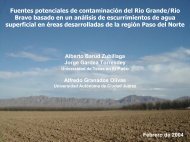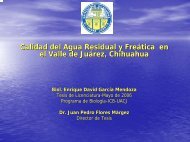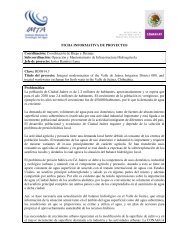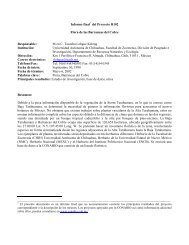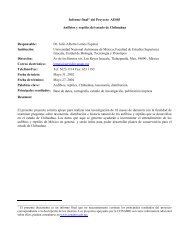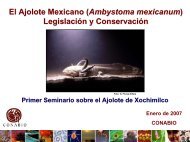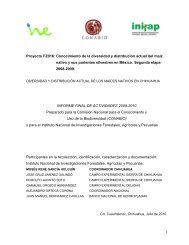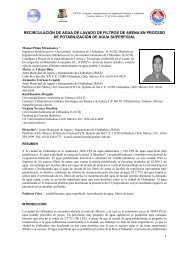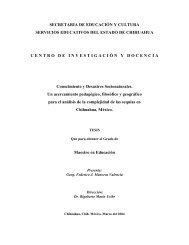land use and land tenure change in the - El Colegio de Chihuahua
land use and land tenure change in the - El Colegio de Chihuahua
land use and land tenure change in the - El Colegio de Chihuahua
You also want an ePaper? Increase the reach of your titles
YUMPU automatically turns print PDFs into web optimized ePapers that Google loves.
20blamed for reduc<strong>in</strong>g <strong>the</strong> <strong>in</strong>centive for private <strong>l<strong>and</strong></strong>hol<strong>de</strong>rs to <strong>in</strong>vest <strong>in</strong> improvements on <strong>the</strong>ir own <strong>l<strong>and</strong></strong>)<strong>and</strong> a transfer of property rights to <strong>the</strong> ejidos.Un<strong>de</strong>r this law ejidos are permitted to sell <strong>l<strong>and</strong></strong> (with a two-thirds vote), to dissolve <strong>the</strong>mselves <strong>and</strong>privatize, to enter <strong>in</strong>to partnerships or rental agreements, <strong>and</strong> to <strong>use</strong> usufruct rights as collateral forcommercial credit. Individual <strong>l<strong>and</strong></strong>hold<strong>in</strong>gs are still limited, while corporate <strong>l<strong>and</strong></strong>hold<strong>in</strong>gs are nowpermitted but restricted to 25 times <strong>the</strong> <strong>in</strong>dividual limit.Ejidos have traditionally been controlled by a specialized government bureaucracy centered onagrarian reform, with a broad set of regulations <strong>and</strong> agencies <strong>in</strong>fluenc<strong>in</strong>g ejidal <strong>de</strong>cisions. S<strong>in</strong>ce agriculturalreforms started <strong>in</strong> 2991, ejidos have become more <strong>in</strong><strong>de</strong>pen<strong>de</strong>nt. Although still <strong>in</strong> <strong>the</strong> public doma<strong>in</strong>,ejiditarios are more able to dictate what takes place on <strong>the</strong>ir own <strong>l<strong>and</strong></strong>. This <strong>in</strong>clu<strong>de</strong>s <strong>the</strong> ability to <strong>use</strong> <strong>l<strong>and</strong></strong>as collateral for mortgages, to “<strong>in</strong>dividualize <strong>and</strong> privatize” ejidal <strong>l<strong>and</strong></strong>s, <strong>and</strong> to cooperate with privatecompanies to <strong>de</strong>velop <strong>the</strong> <strong>l<strong>and</strong></strong>. On <strong>the</strong> o<strong>the</strong>r h<strong>and</strong>, <strong>the</strong> ejido has, for most of this century, existed as a socia<strong>l<strong>and</strong></strong> political unit, central to <strong>the</strong> national i<strong>de</strong>ntity. S<strong>in</strong>ce <strong>the</strong> reform, no new ejidos are be<strong>in</strong>g created.Beca<strong>use</strong> no new <strong>l<strong>and</strong></strong> will be distributed <strong>in</strong> <strong>the</strong> form of ejidos, <strong>l<strong>and</strong></strong> un<strong>de</strong>r ejido control can only shr<strong>in</strong>k. It isdifficult to discern clear trends, as <strong>the</strong> process of <strong>l<strong>and</strong></strong> titl<strong>in</strong>g, carried out by PROCEDE, is off to a slow start<strong>and</strong> ejidos must pass through several stages of titl<strong>in</strong>g <strong>in</strong> or<strong>de</strong>r to form partnerships. It is clear, however, thatejidal <strong>l<strong>and</strong></strong> is already be<strong>in</strong>g privatized <strong>in</strong> both rural <strong>and</strong> urban areas, <strong>and</strong> that structural <strong>in</strong>equities <strong>and</strong>imperfect market conditions at times reduce <strong>the</strong> leverage that ejidos have <strong>in</strong> negotiat<strong>in</strong>g partnerships <strong>and</strong>contracts.Although many studies have shown that small ejido plots are as productive as larger producers, <strong>the</strong>state’s withdrawal from <strong>the</strong> sector prior to <strong>the</strong> creation of function<strong>in</strong>g credit <strong>and</strong> <strong>in</strong>put markets makes itlikely that many of <strong>the</strong>se small producers will leave <strong>the</strong> sector, particularly given <strong>the</strong> rapid reduction <strong>in</strong>tariffs <strong>and</strong> quantitative restrictions on imports In many cases, however, observers predict that ejidos willreta<strong>in</strong> <strong>the</strong>ir <strong>l<strong>and</strong></strong>, as <strong>the</strong> poor quality of much of it will make it unattractive to private capital (Alcala et al).Ejiditarios with larger <strong>l<strong>and</strong></strong>hold<strong>in</strong>gs are predicted to survive more readily than those with smaller,fragmented hold<strong>in</strong>g who are forced to seek off-farm employment to supplement <strong>the</strong>ir <strong>in</strong>comes.E.5.O<strong>the</strong>r important factor <strong>in</strong> MexicoImportant new elements <strong>in</strong> Mexican <strong>l<strong>and</strong></strong> policy are <strong>the</strong> <strong>change</strong>s associated with political<strong>de</strong>mocratization <strong>and</strong> <strong>de</strong>centralization. Over <strong>the</strong> last ten years, <strong>the</strong> dom<strong>in</strong>ation of <strong>the</strong> PRI, <strong>the</strong> party that hasruled Mexico s<strong>in</strong>ce <strong>the</strong> Revolution has been ero<strong>de</strong>d by <strong>the</strong> growth of opposition parties <strong>and</strong> <strong>de</strong>m<strong>and</strong> for fairelections. In <strong>the</strong> <strong>Chihuahua</strong>n Desert of Mexico, political <strong>change</strong> is evi<strong>de</strong>nt <strong>in</strong> several opposition governors<strong>and</strong> <strong>in</strong> opposition votes at <strong>the</strong> municipal <strong>and</strong> local level especially for PAN right w<strong>in</strong>g party.At <strong>the</strong> same time moves have been ma<strong>de</strong> to <strong>de</strong>centralize <strong>de</strong>cision mak<strong>in</strong>g to state <strong>and</strong> municipallevels, <strong>in</strong>clud<strong>in</strong>g <strong>the</strong> enforcement <strong>and</strong> management of a number of environmental <strong>and</strong> <strong>l<strong>and</strong></strong> <strong>de</strong>velopmentprograms. In most cases, <strong>in</strong>a<strong>de</strong>quate f<strong>in</strong>ancial resources have accompanied <strong>the</strong> new responsibilities.Political action <strong>and</strong> social movements organized around environmental issues grew rapidly dur<strong>in</strong>g<strong>the</strong> 1980’s, partly <strong>in</strong> response to <strong>the</strong> <strong>in</strong>a<strong>de</strong>quacy of Mexico’s environmental laws, but also wi<strong>the</strong>ncouragement from <strong>the</strong> government, which feared <strong>the</strong> rise of opposition political parties us<strong>in</strong>g green<strong>the</strong>mes (Mumme, Bath et al., 1988). Mexico City <strong>and</strong> <strong>the</strong> US-Mexico bor<strong>de</strong>r became <strong>the</strong> locus for <strong>the</strong><strong>de</strong>velopment of social movements around urban issues of crime <strong>and</strong> pollution, whereas rural movementsfoc<strong>use</strong>d on access to <strong>l<strong>and</strong></strong>, water <strong>and</strong> credit (Fowermaker <strong>and</strong> Craig. 1990). By <strong>the</strong> 1990s Torres reports 130non-governmental organizations <strong>in</strong> Mexico City <strong>and</strong> 330 elsewhere <strong>in</strong> Mexico. [Torres, 1997 #2159].By <strong>the</strong> end of <strong>the</strong> 1980s, public <strong>and</strong> political awareness of environmental issues was relatively high<strong>in</strong> Mexico accord<strong>in</strong>g to a 1989 study conducted for UNEP, which surveyed 400 members of <strong>the</strong> public <strong>and</strong>52 <strong>de</strong>cision makers about environmental problems (Harris, 1989). The study found that 61% of <strong>the</strong> public<strong>and</strong> 88% of <strong>de</strong>cision makers th<strong>in</strong>k <strong>the</strong> environment has become worse <strong>in</strong> Mexico <strong>in</strong> <strong>the</strong> last ten years; morethan 80% of both groups felt this poses a great danger to human health. Mexicans had higher levels ofconcern about environmental issues than most o<strong>the</strong>r countries. More than 90% of both <strong>the</strong> public <strong>and</strong>



